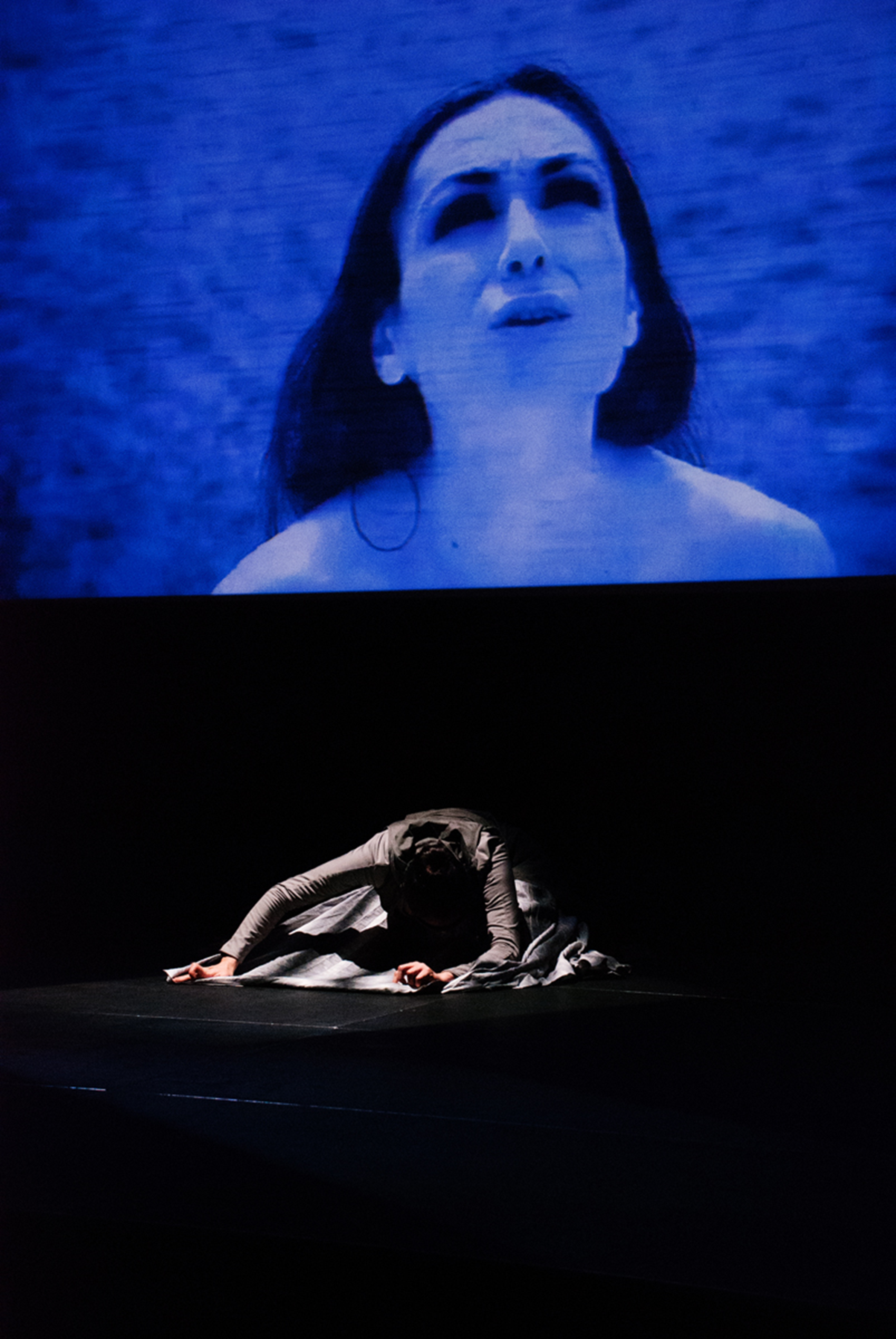Top-Ranked LABS Abstracts 2017
The Leonardo Abstracts Service (LABS) is an evolving, comprehensive database of thesis abstracts (PhD, Master's and MFA) on topics at the intersections between art, science and technology. This English-language database is hosted by Pomona College (Claremont, CA), under the direction of editor-in-chief Sheila Pinkel.
Each year, in addition to being published in the database, a selection of abstracts chosen by a peer review panel for their special relevance are published annually in Leonardo (see Vol. 51, No. 5, October 2018) and on our website. We are pleased to present below the top-ranked thesis abstracts of 2017, and we congratulate the authors of the theses.
- Nora S. Vaage, Amplifying Ambiguities: Art on the Fringes of Biotechnology (Highest-Rated Abstract)
- Adam Collis, Establishing a Critical Framework for the Appraisal of “Noise” in Contemporary Sound Art with Specific Reference to the Practices of Yasunao Tone, Carsten Nicolai and Ryoji Ikeda
- Tyler Fox, Transductive Praxis in BioArt
- Gabriela Galati, Duchamp Meets Turing: Art, Modernism, Posthuman
- Vincent Giles, Microsound, Spectra, and Objectivity: Tracing Memetics in Organized Sound
- Jennifer no.e Parker, Composing [De]Composition: Data Sonification for Sound Art and Music Composition
- Lotte Pet, When CRISPR Meets Art: The Experience of Relationality Through the Affective Agency of Matter
- Marco Pinter, Robotic Sculpture Development through Appropriated Choreographic Strategies, Facilitating Artistic Exploration of Visual Perception, Object-ness, and Symbiosis between Physical and Virtual Media
- Carlos C. Praude, Computer Art and Actor-Network Theory: Actants and Intersubjective Associations in Scene
- Hannah Star Rogers, The Practices of Art and Science
- Winnie Soon, Executing Liveness: An Examination of the Live Dimension of Code Inter-actions in Software (Art) Practice
- Tanya Toft, Contemporary Urban Media Art—Images of Urgency: A Curatorial Inquiry
- Polina Zioga, Live Brain-Computer Cinema Performance
Amplifying Ambiguities: Art on the Fringes of Biotechnology
Nora S. Vaage
Since the 1980s, bioart has emerged as an important art form alongside the transition to the 21st century, often described, both optimistically and ominously, as the “biotech century.” This doctoral dissertation studies artists’ engagements with wet biotechnologies, considering bioart in relation to the related approaches of DIYbio and biodesign. The thesis navigates the tension between bioart’s topical and methodological relationship to biotechnology and its claims to some other aesthetic quality defining it as art.
What is the specificity of bioart in relation to related phenomena on the topic of biotechnology? The author contends that bioart is a heterogeneous field that is, in important ways, singular as an artistic approach to the biotechnosciences, while simultaneously being closely interlinked with DIYbio and biodesign, as well as biotechnology and the art world. This thesis is based on a case study performed at the SymbioticA Centre for Excellency in Biological Arts, supplemented by participant observation in numerous other contexts, including community laboratories, workshops, visits to exhibitions and conversations with practitioners of bioart, DIYbio and biology.
What ethical issues do bioartworks raise and address? How are these practices performed and perceived? What possibilities and challenges do they carry? The results of the research show that art can give nonspecialists an increased understanding of biotechnosciences and their impact on society, but also that artists are uncomfortable with focus on the function of their art. There is a strong sense that art needs to convey something more than instrumentalist aims.
Nora S. Vaage: n.vaage@maastrichtuniversity.nl. PhD thesis, University of Bergen, Norway, 2016.
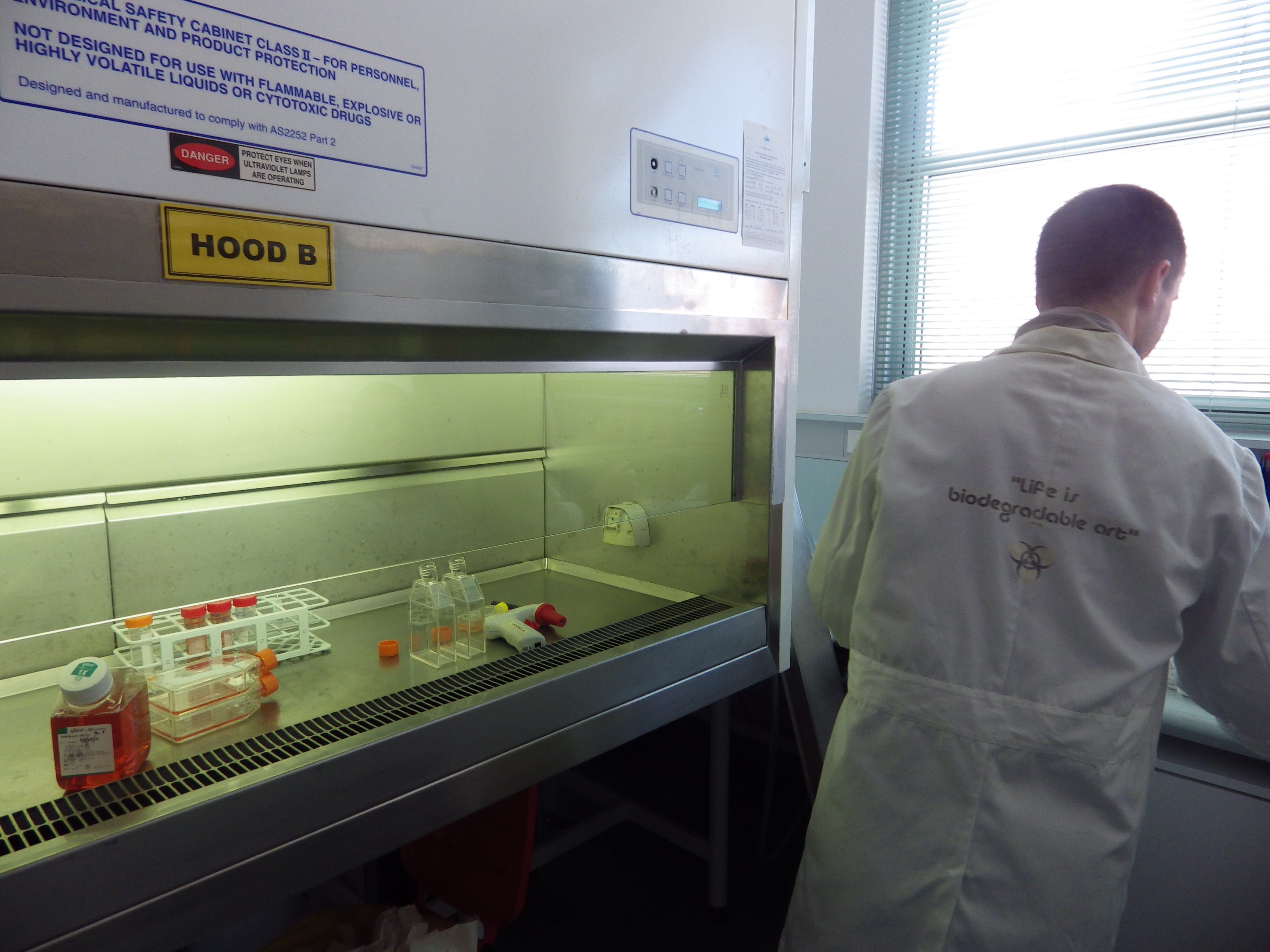
Laboratory work at SymbioticA, artist Benjamin Forster doing tissue culture work. © Nora Vaage, 2013.
Establishing a Critical Framework for the Appraisal of “Noise” in Contemporary Sound Art with Specific Reference to the Practices of Yasunao Tone, Carsten Nicolai and Ryoji Ikeda
Adam Collis
Yasunao Tone, Carsten Nicolai and Ryoji Ikeda are three practitioners representative of electronic music and sound-art practices that emerged in the 1990s where sound materials not normally considered musical, such as digital clicks, glitches and bursts of white noise, are prevalent. The origins of this body of work lie outside of the established music institutions of academia and the mainstream popular music industry and practitioners are often associated with particular record labels including Mille Plateaux or Raster-Noton. While attempts have been made to coalesce these practices into a single unified genre, these assessments tend to critique work mainly in technological terms.
In contrast, this thesis draws out deeper philosophical concerns relevant to these practices through a critical analysis of materials produced by and about these practitioners, including commercial releases, works, writings and interviews. What emerges from this is that Heidegger’s notion of truth as ‘revealing’ and Derrida’s critique of phonocentrism can provide a clearer philosophical framework for a consideration of this body of work. It is argued that these practices reflect a wider cultural shift away from the notion of “value” as something quantified, abstract and intrinsic, towards one concerned with the qualitative, contextual and extrinsic, and that these practices are forms of conceptual sound art that challenge both notions of “absolute” music and prevailing political-economic structures.
Adam Collis: a.collis@coventry.ac.uk. PhD Thesis, University of Surrey, United Kingdom, 2016.
Transductive Praxis in BioArt
Tyler Fox
In this dissertation, I utilize the philosophy of Gilbert Simondon to form a theoretical framework for making BioArt. BioArt, for this research, means artwork that incorporates living, nonhuman organisms. Simondon adopts a relational ontology to argue that individuation, or how things come to be, is ongoing and processual. His philosophy provides an understanding of the relations between entities, between individuals and their sustaining environments. Simondon argues his philosophy is generalizable across all regimes of existence (physical, living, technological, psychosocial), but specific to the context of a given set of relations. Simondon offers critical concepts for the consideration and creation of BioArt, especially techno-aesthetics. I use Simondon’s techno-aesthetics to build a method and approach to creating BioArt. I eschew an understanding of BioArt that only emphasizes the practices, tools and processes from the biotechnology industry as the underlying requirement of the genre. Rather than limiting our understanding of what BioArt is, I argue for an opening up of our understanding of what BioArt can be. It represents a research path that brings relations between humans, technology, and living, nonhuman organisms to the fore. My research seeks to understand how BioArt can foster shared experiences between humans and nonhumans. I discuss the development of two different projects, one in the final stage and one in the nascent stage. They offer both physical instantiations of the theories and arguments of my research, as well as objects of analysis through which I explore and expand upon Simondon’s philosophy.
Tyler Fox: foxt@uw.edu. PhD thesis, Simon Fraser University, 2015.
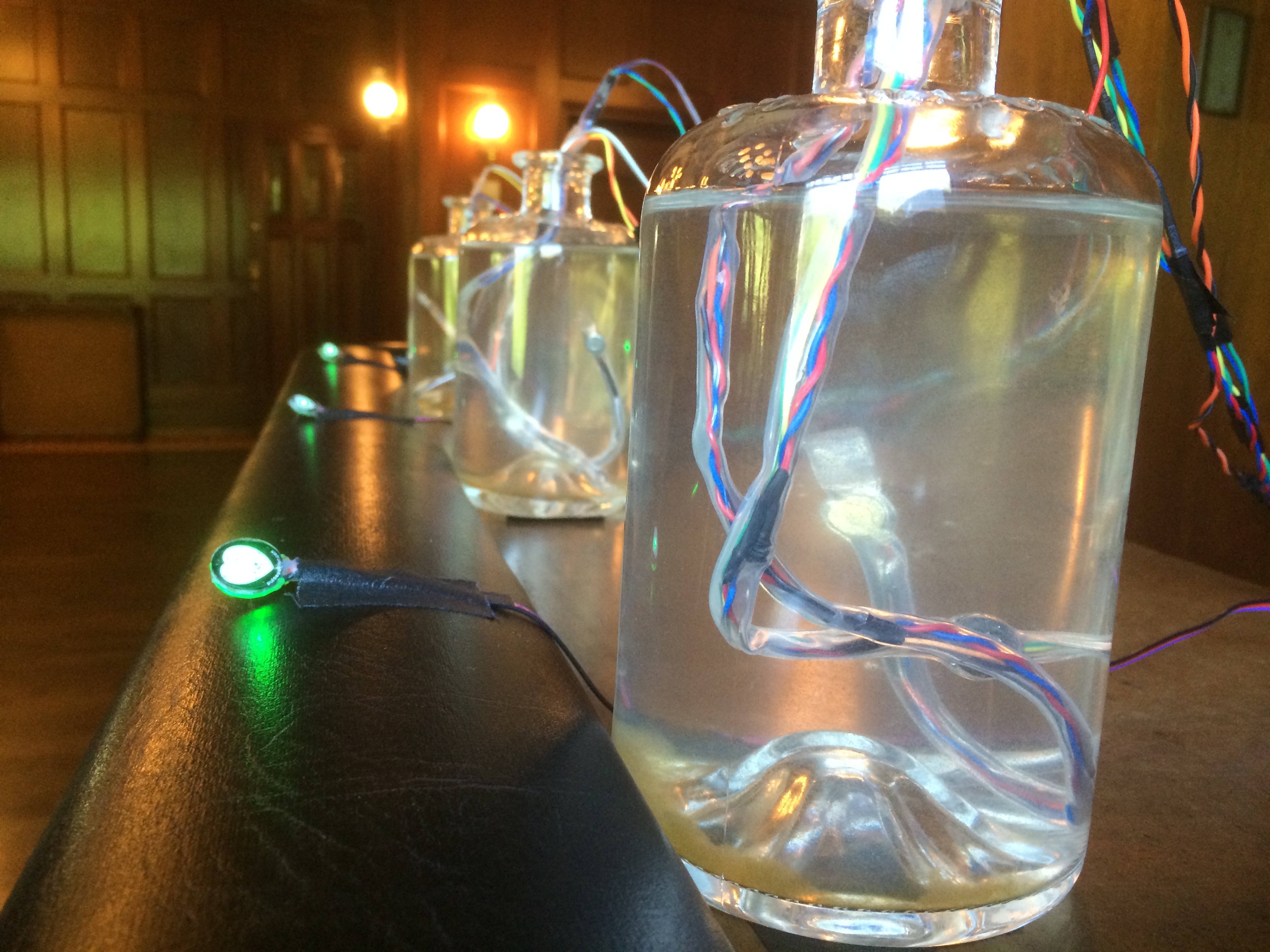
Tyler Fox, Biolesce 0.5, interactive installation: P. fusiformis, seawater, button motors, heartbeat sensor, Arduino Uno, 2015. (© Tyler Fox)
Duchamp Meets Turing: Art, Modernism, Posthuman
Gabriela Galati
This work proposes to consider that the actual overcoming of modernism comes along with the advent of the posthuman—tracing its origin to Marcel Duchamp and his invention of the readymade—and not with postmodernism, the theoretical consistency of which, at least in the artistic field, this research questions.
Katherine Hayles analyzed the process through which the conception of the liberal humanist subject led the way to the posthuman subject, a subject who lives in complete entwinement with the digital. This process, however, was not innocuous: It made the (fallacious) perception that information could do without material instantiation pervasive within many fields of knowledge. This research identifies an analogous process within the artistic realm: When Clement Greenberg delineated the concepts of opticality and color field as the main characteristics that defined Modernist painting, he conceived of these in a purely disembodied subject.
Understanding digitalization processes not as representations of some material reality but as ontological repetitions, and analyzing the archive not only as an issue of memory but also of conformation of both the future and subjectivities, this work advances the emergence of a digital subject and theorizes that its constitution happens by assuming a “point of view” in the technological unconscious.
These theorizations, which are part of the posthuman, are presented as the actual overcoming of modernism to show that the readymade as a medium is, at the same time, both one of the points of rupture and the key link to bring back new media and art theory as art at large.
Gabriela Galati: gabrielagalati@gmail.com. PhD thesis, Plymouth University, U.K., 2016.

Massimiliano Viel, Cluster_03, digital image, 2014. (© Massimiliano Viel)
Microsound, Spectra, and Objectivity: Tracing Memetics in Organized Sound
Vincent Giles
This dissertation proposes a novel memetic framework and creative methodology to probe the mechanism underpinning the transmission of a composer’s intention to an audience, contending that cultural replicators—memes—drive our understanding of a composer’s intention. The author hypothesizes that memes catalyze the creation of artifacts, which, in turn, act as instigators for memetic replication in the brain, and that microsound—sound at the edge of perception—may play a key role in instigation.
Thinking about these hypotheses yields creative deployment of microsound in primarily scored works. The creative process allows the researcher to arrive at a deeper understanding of memetics and formalize the conceptual memetic framework and hypotheses described herein. Thus theory and practice become interlocked in the search for evidence of memes in the creation of works of organized sound and the role that memes play in an audience’s ability to (re)construct the intention of a composer.
Four notated/semi-notated musical compositions and one piece of software (made in MaxMSP) are included as support for the framework: Mozart Variations, silver as a catalyst in organic reactions, End to Reattain, It needs a big ‘ow’ sound; ow-nd . . . ground! and the Spectral Domain Microsound Amplification Software (SDMAS), along with a significant number of other works and projects not discussed in-text. Each of these works/projects contributed significant shifts in understanding the role that memes may play in intention/reception and are reflected upon in-text.
Vincent Giles: vin@vgiles.net. PhD thesis, The University of Melbourne, Australia, 2017.
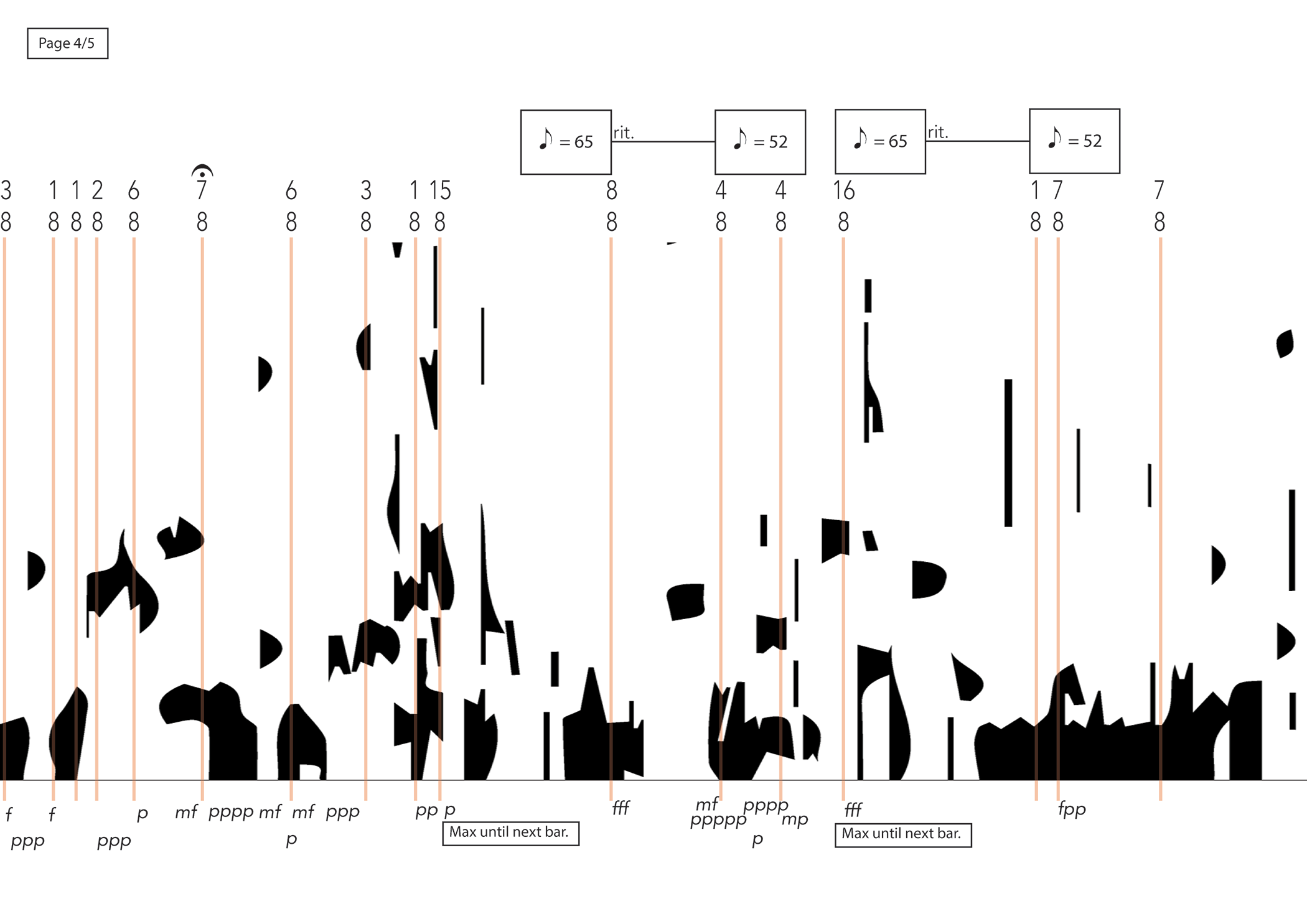
Vincent Giles, excerpt from “it needs a big ‘ow’ sound; ow-nd . . . ground!” music score, 2017. (© Vincent Giles)
Composing [De]Composition: Data Sonification for Sound Art and Music Composition
Jennifer no.e Parker
First presented at University of California Riverside’s Sweeney Art Gallery in 2015, Composing [De]Composition is a sonically oriented bioart research installation that recontexualizes compost as a rich site for creative exploration and expression via data sonification. Data sonification brings a perceivably silent physical/biochemical activity into the tangible range of human hearing, allowing the biota to be a source of vastly different sonic experiences. In this thesis, the author reframes the composting process as artistic material and collaborator, deploying a DIY/maker’s approach, connecting organic waste disposal, data collection and visualization as grist for sound art and music composition.
The key observable driving C[D]C is the heat generated by the compost. In this thesis the author describes the evolution of a poly-temporal, multi-agential, and techno-ecological artistic praxis, involving the development of a data-audio display to sense, audify and collect real-time temperature data; parameter mapping; sound design; dataset-based digital music composition; and data musification strategies. The real-time audification of temperature, using data from a custom interface routing sensor to a multi-point audio display, enables listeners to better apprehend the complex ecology of a heterogeneous mass simultaneously decomposing while supporting a myriad of life forms. Similarly, as music builds upon patterns of pitch, rhythm and dynamics through time, sonification of temperature datasets clearly reveal inherent patterns occurring in the system. While creating fertile ground for exploration in the realm of music composition, this also enables the composer/sound artist to create works in partnership with her phenomenon of study.
Jennifer no.e Parker: Jno.eParker@gmail.com. PhD thesis, University of California, Riverside, U.S.A., 2016.
![Composing [De]Composition Data Listening Session at U.C. Riverside’s Sweeney Art Gallery, October 2016. (© Jennifer no.e Parker. Photo: Nikoly Maslov.) Composing [De]Composition Data Listening Session at U.C. Riverside’s Sweeney Art Gallery, October 2016. (© Jennifer no.e Parker. Photo: Nikoly Maslov.)](https://leonardo.info/sites/default/files/media_panes/parker_fig1.jpg)
Composing [De]Composition Data Listening Session at University of California Riverside’s Sweeney Art Gallery, October 2016. (© Jennifer no.e Parker. Photo: Nikoly Maslov.)
When CRISPR Meets Art: The Experience of Relationality Through the Affective Agency of Matter
Lotte Pet
When CRISPR Meets Art deals with the value of art in relation to the human enhancement debate that is sparked by the genome editing technique CRISPR. This biotechnology allows for the alteration of DNA with much stronger precision and lower costs than previous methods and is being quickly and widely applied in the field of bioengineering. Consequently, people are being confronted with biotechnology’s socio-cultural impact and forced to formulate opinions on issues that touch upon notions of life, death and the future and meaning of humanity. A univocal opinion is absent and the debate on human enhancement shows many different and incommensurable positions. Therefore, alternative methods of engagement for experts and laypeople need to be developed, as well as a means to overcome the current stalemated position. Affect theory and concepts from posthumanism and new materialism show that these can be found in bioart: the field of art in which techniques and materials of the Life Sciences are used in artistic practices to construct a better understanding of the ethical and societal implications of biotechnology. Bioartists are known for confronting people with intrinsic perceptions using instances such as shock, fascination and confusion. The material nature of their art provides onto-epistemological frameworks that instigate an awareness of our relational existence that is always in process of becoming. The diverse viewpoints show that the understanding of biotechnology’s significance cannot be achieved only through language and representations. Instead, it has to be known through the affective force of art.
Lotte Pet: lottepet@gmail.com. Masters thesis, Leiden University, Netherlands, 2016.
Robotic Sculpture Development through Appropriated Choreographic Strategies, Facilitating Artistic Exploration of Visual Perception, Object-ness, and Symbiosis between Physical and Virtual Media
Marco Pinter
The domain of dance enjoys a centuries-long history of exploring movement through choreography. This dissertation illustrates the appropriation of choreographic techniques from the domain of dance to the domain of kinetic sculpture through the use of robotic technologies and tools.
The research draws upon a schema of 16 motif manipulations by Blom and Chaplin, as well as the Laban effort actions, and techniques of chance and indeterminacy employed by John Cage and Merce Cunningham. The author presents software tools that have been developed to enable these appropriations.
The thesis provides a review of literature on motor cortex activity produced when observing dance and robotic systems. The review informs a new linear model of motor-brain activation in art, illustrating that the present research enables the creation of “bio-kinematic sculpture,” a sculptural form facilitating viewer brain activation.
The thesis shows that choreographic manipulation also enables artistic exploration of visual perception and related philosophical concepts. A classification for visual artwork that exploits low-level visual perception reveals an uncharted gap in visual art that explores perceptual constructs through choreographed robotic sculpture. The author provides examples from his practice that exploit the phenomenon of object permanence through the cybernetic interaction of physical and virtual media within a shared ecosystem.
The research suggests that a formal system of choreographic development, with supporting tools and methodologies, allows the creative freedom to explore sculptural motion in an unencumbered process of experimentation and observation.
Marco Pinter: contact (at) fusion-artist.com. PhD thesis, University of California, Santa Barbara, U.S.A., 2015.
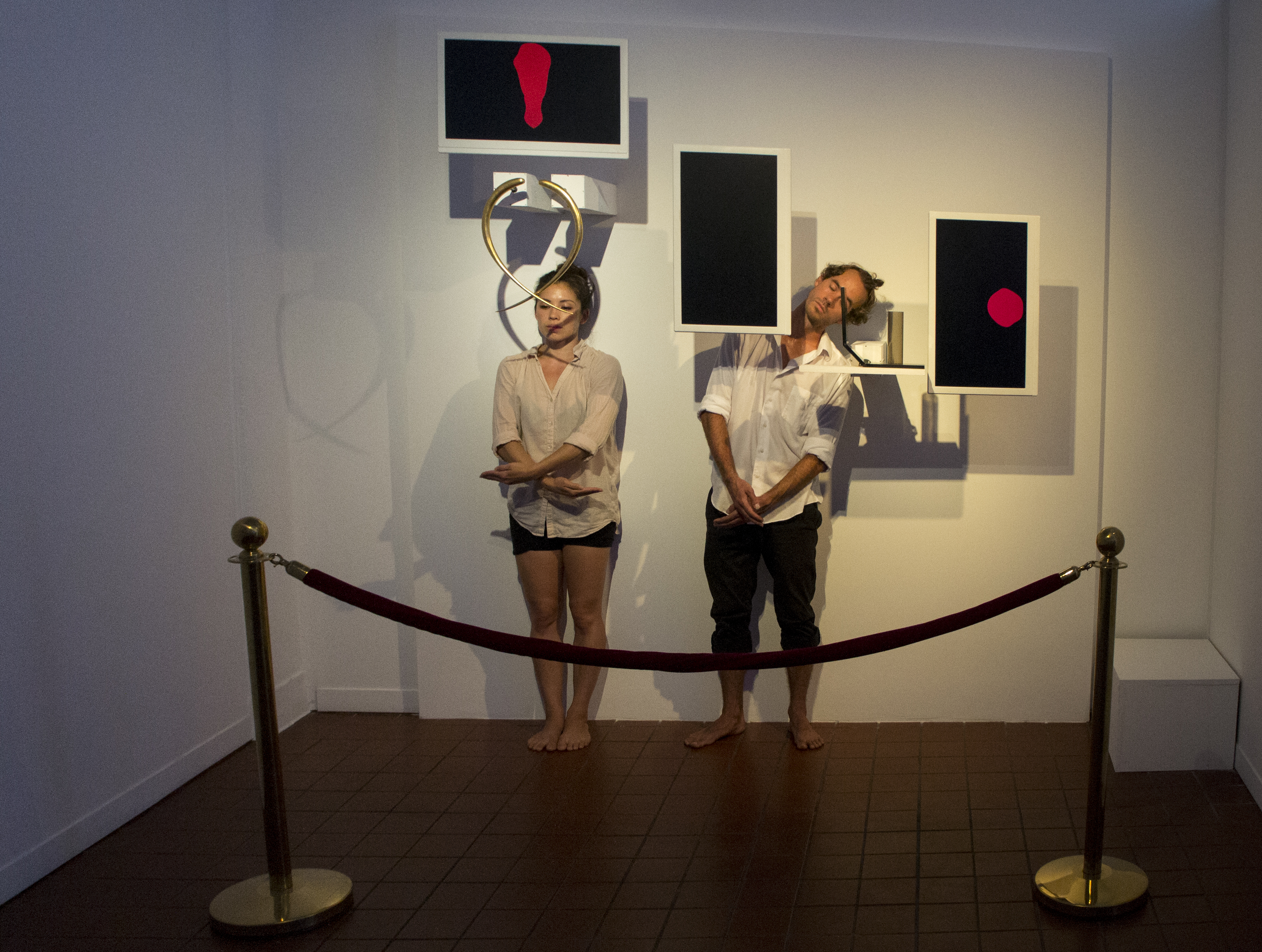
Marco Pinter, “Object Permanence III: Non-Dual” with dancers Kaita Lepore and Tim Wood, 2014. (© Marco Pinter)
Computer Art and Actor-Network Theory: Actants and Intersubjective Associations in Scene
Carlos C. Praude
This paper investigates how Actor-Network Theory contributes to the innovation of aesthetic states in artistic production and proposes a theoretical framework for the creative process in terms of computer art.
This paper is a result of a PhD thesis that establishes associations between the Actor-Network Theory (ANT) and computer art. ANT originated from research investigating the dynamics of knowledge production within a laboratory with the use of technological artifacts where humans and nonhumans, called actants, were analyzed with the same level of importance. Computer art finds its roots in information theory and in the sign systems that are proposed as objects from the perspective of informational aesthetics, as stated by Abraham Moles and Max Bense.
The research articulates concepts known as actant, association, translation and inscription, from ANT, based on definitions presented by Bruno Latour, and the terms repertoire of elements, message, object and aesthetic states, from informational aesthetics. Developing the analysis of interactive installations of the author’s own creation, most of them being applied in theatrical staging, the research investigates how ANT contributes to the innovation of aesthetic states in artistic production and builds a theoretical framework that collaborates to the creative process in terms of computer art. Expanding informational aesthetics with ANT, the research proposes an aesthetic of associations, which takes a different view focusing on the connections established between the actants participating in the art object.
Carlos C. Praude: ccpraude@gmail.com. PhD thesis, Universidade de Brasília, Brazil, 2015.
The Practices of Art and Science
Hannah Star Rogers
This dissertation explores the question of how art and science work as categories to circumscribe bodies of knowledge. People engage in rhetorical positioning through the creation of texts, style choices, making and unmaking the meanings of objects. Objects can be made to fit into the knowledge networks of art, science or combinations of both. For different practitioners and audiences, what counts as art or science and their association varies in interesting ways.
The categories of art and science serve many purposes. They indicate the kind of attention people, objects and ideas want to elicit from readers, viewers and thinkers. They serve to demarcate resources, to delineate interests and to separate social groups. This dissertation contains three core case studies: the story of the Blaschka’s nineteenth-century glass scientific models, the story of the 1990s tactical media movement, and the story of bioart as practiced in a biological wet lab in Australia.
By unpacking the ways actors have used these categories, the author complicates the division between the realms of art and science, examines their relative power in different contexts, and shows that science studies tools can be applied to artistic practice with fruitful results that offer new ways of thinking about people and objects that have often fallen outside the scope of science studies research. The author’s analysis details the forms of knowledge produced by art and science in these contexts.
Hannah Star Rogers: hsr9@cornell.edu. PhD thesis, Cornell University, U.S.A., 2012.
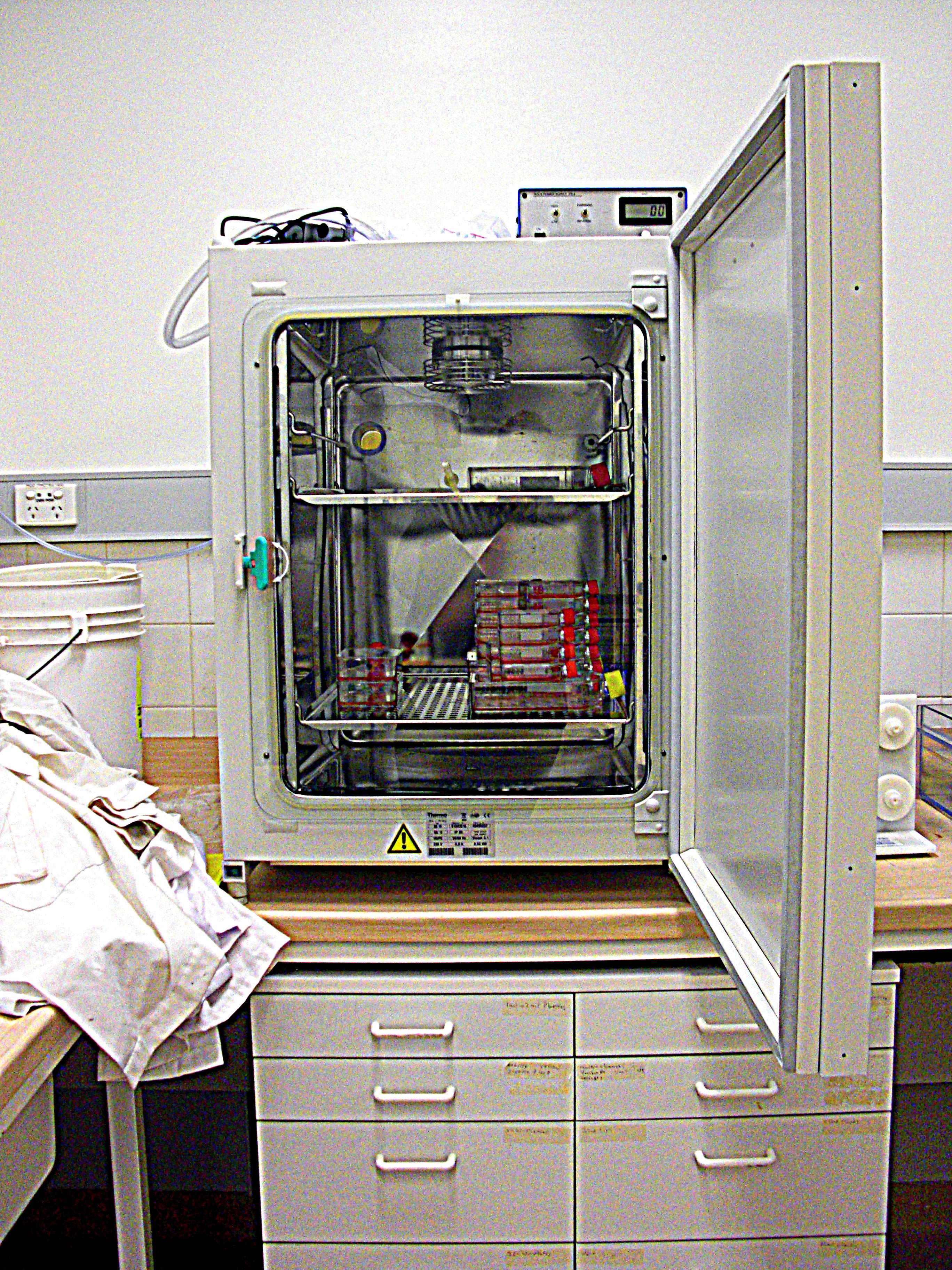
SymbioticA Lab at the University of Western Australia, 2009. (© Hannah Star Rogers)
Executing Liveness: An Examination of the Live Dimension of Code Inter-actions in Software (Art) Practice
Winnie Soon
With today’s prevalence of technology, enormous quantities of data are generated and disseminated in real time through a highly networked, programmable and distributed environment. Networks of machines and the circulation of data mediate our sense of time. The sensation of “liveness” is deeply reconfigured by complex technological infrastructures behind ubiquitous screens and interfaces. This thesis explores how real-time computation reconfigures the immanent sense of liveness, examining the complexity of our current computational environment as evident in the increasing use of data queries, the instantaneous transmission of data streams and the seamless running of automated agents.
A materialist framework for liveness is presented with the use of three main vectors, namely: unpredictability, micro-temporality and automation. By drawing together the methods of reflexive practice, close reading, iterative trials and cold gazing in the fields of artistic research, critical code studies, software studies and media archaeology respectively, this thesis presents three artistic and experimental projects along with the written manuscript. Together they examine barely visible code operations and consider the cultural implications of the reading, writing, running and execution of code, which the author refers to as “reflexive coding practice.” This methodology provides an applied approach to computational processes, invisible architectures and a means to reflect on cultural issues through experimentation and practice. The analysis and discussion contributes to a widening of critical attention to software (art) studies and includes a nuanced examination of liveness beyond immediate human reception.
Winnie Soon: wsoon@cc.au.dk. PhD thesis, Aarhus University, Denmark, 2016.
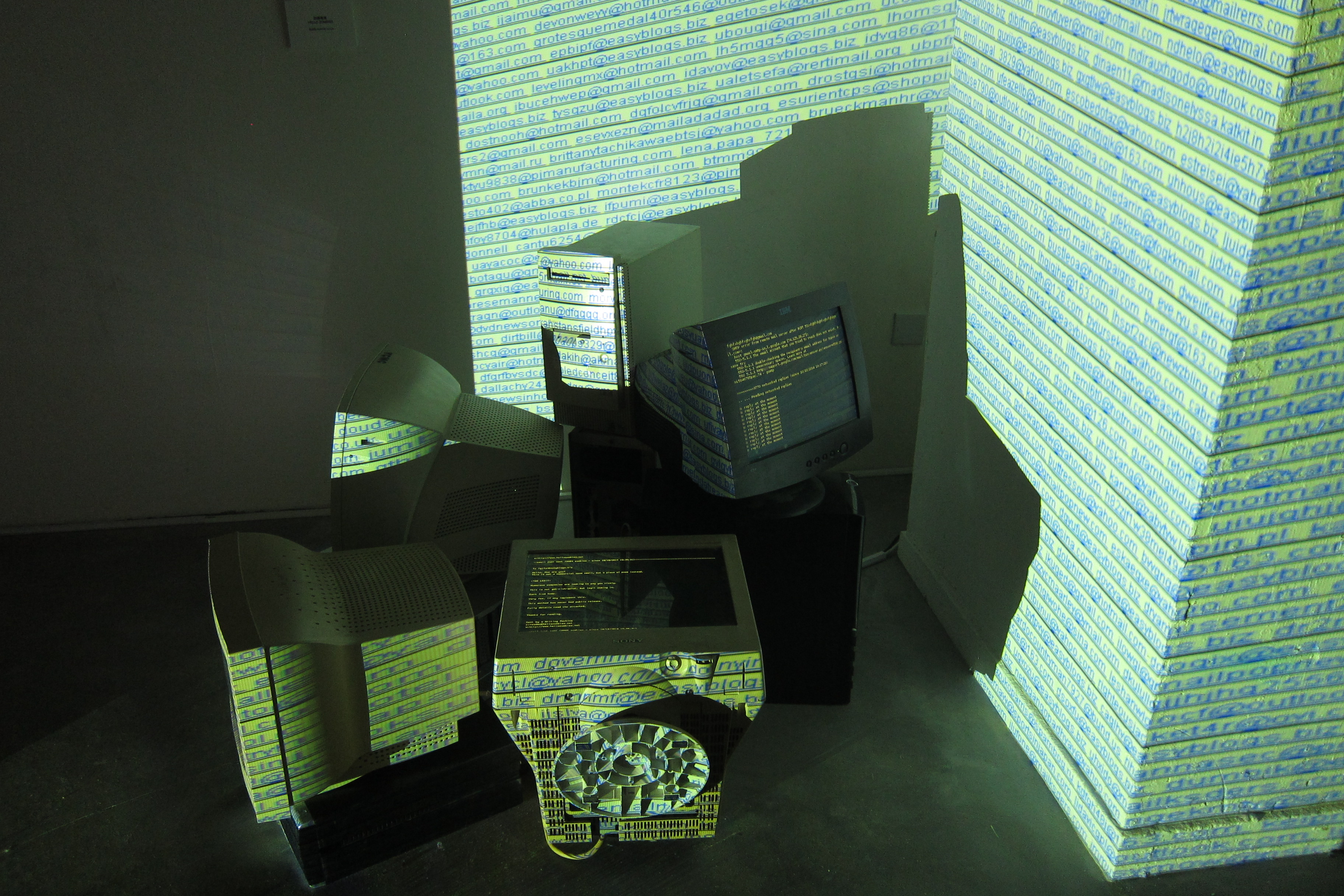
Winnie Soon, Hello Zombies networked installation, custom software, 2014. (© Winnie Soon)
Contemporary Urban Media Art—Images of Urgency: A Curatorial Inquiry
Tanya Toft
This dissertation unfolds through an inquiry into human perceptual experience in media aesthetic conditions of our contemporary, communicative existence, namely in urban contexts of highly technologically developed environments. It examines overall, from a combined academic and curatorial perspective, how urban media art—media aesthetic art forms situated in an urban context—may be considered contemporary in the understanding of art that departs from, responds to and co-exists with “time” and temporal experience, and as engaging with perceptual structures and mediated conditions in particular contemporaneities. In inquiring into three media aesthetic tendencies today: intensity, intelligence and immersion, this dissertation examines the art’s contingent relations with our technological contemporaneity. Contemporary conditions of “immersion” are especially problematized in terms of a tendency of spectacularization of behavior (rather than conditioned by spectacles, characterizing our “duration” today, and in terms of images we live through rather than “images” we look at, in light of Henri Bergson’s philosophy of images as sense-impressions. The author suggests that urban media art—as images of urgency oscillating between presence effects and meaning effects—may be considered contemporary by way of its potential real-time interference with site-contextual, environmental-relational and future-virtual realms of distributed sensibility today, levels at which the art’s images potentially affect human perceptual experience and duration.
Tanya Toft: tanyatoft@gmail.com. PhD thesis, University of Copenhagen, Denmark, 2017.
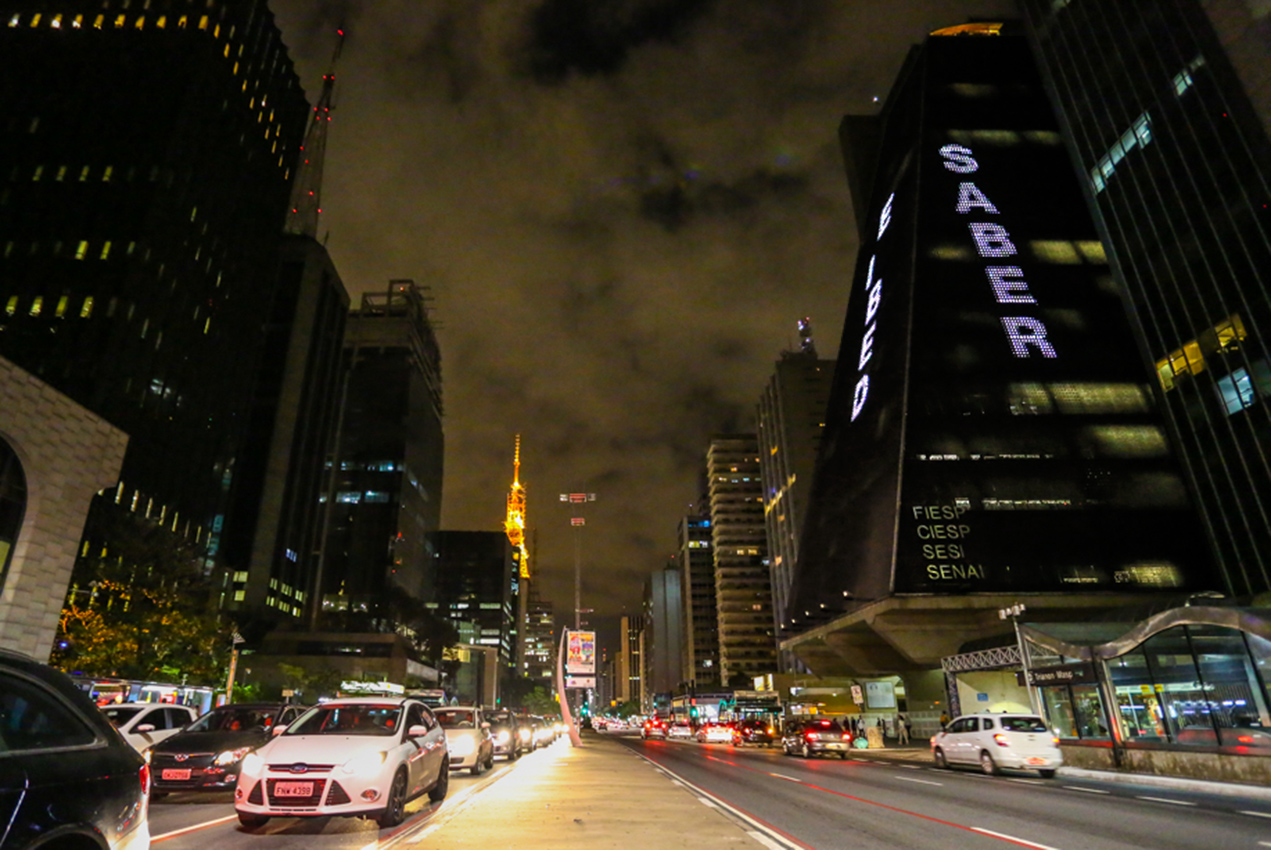
Lucas Bambozzi, Coisa Lida (2014), large-scale responsive video installation, SP Urban Digital Festival 2014, São Paulo. (© Verve Cultural. Courtesy of Lucas Bambozzi and Verve Cultural. Photo by Bia Ferrer.)
Live Brain-Computer Cinema Performance
Polina Zioga
The majority of the applications of Brain-Computer Interfaces (BCIs) in the arts and entertainment use the brain activity of a single participant, although an increasing number involve the interaction of more than one user.
This dissertation investigates the design and implementation of multi-brain electroencephalography (EEG)–based BCIs in the context of live cinema and mixed-media performances. The aim is to identify the interdisciplinary challenges involved and to develop an effective model for the simultaneous multi-brain interactions of performers and audiences.
By combining scientific and practice-based methodologies, a new passive multi-brain EEG-based BCI system was developed and implemented in Enheduanna—A Manifesto of Falling, the first demonstration of a live brain--computer cinema performance (CCA Glasgow, July 2015). This new work enabled the simultaneous, real-time interaction—with the use of EEG-based BCIs—of more than two participants, including both a performer and members of the audience, in the context of a mixed-media performance. The analysis of the participants’ data reveals a correlation between the elements of the performance that they identified as most special and their indicators of attention and emotional engagement, proving the efficiency of the interaction design, the importance of the directing strategy, dramaturgy and narrative structure. Accordingly, the original contributions of the research include the new passive multi-brain EEG-based BCI system, the live brain-computer cinema performance, as a novel format of performative work and as a complete combination of creative and scientific solutions.
Polina Zioga: info@polina-zioga.com. PhD Thesis, Glasgow School of Art, UK, 2017.
